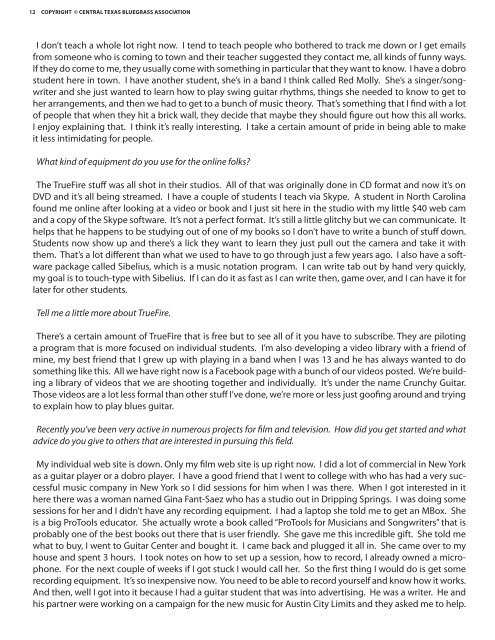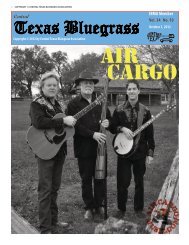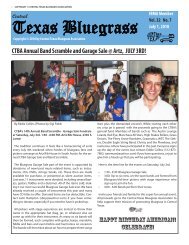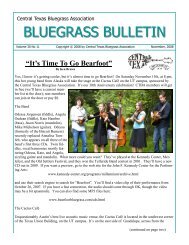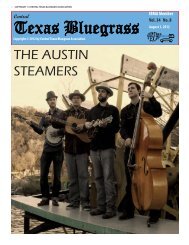a Little: Red Haired Boy (Dobro) - Central Texas Bluegrass ...
a Little: Red Haired Boy (Dobro) - Central Texas Bluegrass ...
a Little: Red Haired Boy (Dobro) - Central Texas Bluegrass ...
You also want an ePaper? Increase the reach of your titles
YUMPU automatically turns print PDFs into web optimized ePapers that Google loves.
12 COPYRIGHT © CENTRAL TEXAS BLUEGRASS ASSOCIATION<br />
I don’t teach a whole lot right now. I tend to teach people who bothered to track me down or I get emails<br />
from someone who is coming to town and their teacher suggested they contact me, all kinds of funny ways.<br />
If they do come to me, they usually come with something in particular that they want to know. I have a dobro<br />
student here in town. I have another student, she’s in a band I think called <strong>Red</strong> Molly. She’s a singer/songwriter<br />
and she just wanted to learn how to play swing guitar rhythms, things she needed to know to get to<br />
her arrangements, and then we had to get to a bunch of music theory. That’s something that I find with a lot<br />
of people that when they hit a brick wall, they decide that maybe they should figure out how this all works.<br />
I enjoy explaining that. I think it’s really interesting. I take a certain amount of pride in being able to make<br />
it less intimidating for people.<br />
What kind of equipment do you use for the online folks?<br />
The TrueFire stuff was all shot in their studios. All of that was originally done in CD format and now it’s on<br />
DVD and it’s all being streamed. I have a couple of students I teach via Skype. A student in North Carolina<br />
found me online after looking at a video or book and I just sit here in the studio with my little $40 web cam<br />
and a copy of the Skype software. It’s not a perfect format. It’s still a little glitchy but we can communicate. It<br />
helps that he happens to be studying out of one of my books so I don’t have to write a bunch of stuff down.<br />
Students now show up and there’s a lick they want to learn they just pull out the camera and take it with<br />
them. That’s a lot different than what we used to have to go through just a few years ago. I also have a software<br />
package called Sibelius, which is a music notation program. I can write tab out by hand very quickly,<br />
my goal is to touch-type with Sibelius. If I can do it as fast as I can write then, game over, and I can have it for<br />
later for other students.<br />
Tell me a little more about TrueFire.<br />
There’s a certain amount of TrueFire that is free but to see all of it you have to subscribe. They are piloting<br />
a program that is more focused on individual students. I’m also developing a video library with a friend of<br />
mine, my best friend that I grew up with playing in a band when I was 13 and he has always wanted to do<br />
something like this. All we have right now is a Facebook page with a bunch of our videos posted. We’re building<br />
a library of videos that we are shooting together and individually. It’s under the name Crunchy Guitar.<br />
Those videos are a lot less formal than other stuff I’ve done, we’re more or less just goofing around and trying<br />
to explain how to play blues guitar.<br />
Recently you’ve been very active in numerous projects for film and television. How did you get started and what<br />
advice do you give to others that are interested in pursuing this field.<br />
My individual web site is down. Only my film web site is up right now. I did a lot of commercial in New York<br />
as a guitar player or a dobro player. I have a good friend that I went to college with who has had a very successful<br />
music company in New York so I did sessions for him when I was there. When I got interested in it<br />
here there was a woman named Gina Fant-Saez who has a studio out in Dripping Springs. I was doing some<br />
sessions for her and I didn’t have any recording equipment. I had a laptop she told me to get an MBox. She<br />
is a big ProTools educator. She actually wrote a book called “ProTools for Musicians and Songwriters” that is<br />
probably one of the best books out there that is user friendly. She gave me this incredible gift. She told me<br />
what to buy, I went to Guitar Center and bought it. I came back and plugged it all in. She came over to my<br />
house and spent 3 hours. I took notes on how to set up a session, how to record, I already owned a microphone.<br />
For the next couple of weeks if I got stuck I would call her. So the first thing I would do is get some<br />
recording equipment. It’s so inexpensive now. You need to be able to record yourself and know how it works.<br />
And then, well I got into it because I had a guitar student that was into advertising. He was a writer. He and<br />
his partner were working on a campaign for the new music for Austin City Limits and they asked me to help.


